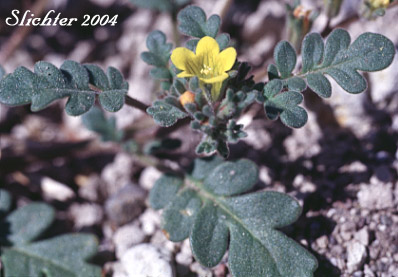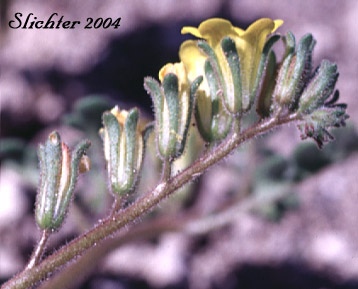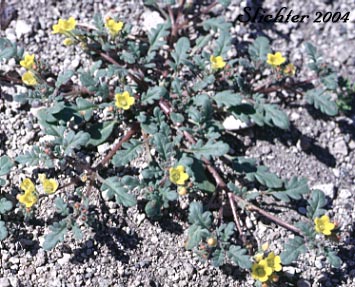

 The
photo at right shows a close-up, side view of yellow phacelia as seen near Flagstaff
Lake in the Warner Valley of south-central Oregon.........June 24, 2003. Note that the corollas are slightly longer than the calyx lobes.
The
photo at right shows a close-up, side view of yellow phacelia as seen near Flagstaff
Lake in the Warner Valley of south-central Oregon.........June 24, 2003. Note that the corollas are slightly longer than the calyx lobes.
Yellow phacelia is an annual wildflower with prostrate to spreading, freely branched stems spreading to form mats as much as 40 cm across. The thick, petiolate leaves are oblanceolate to elliptic or ovate in outline with entire margins or some with several broad, rounded lobes. The blades are up to 2.5 cm long and up to 1.5 cm wide.
The numerous inflorescences are small and consists of several yellow, bell-shaped or tubular-bell-shaped corollas. The tube is about 2-3 times longer than the corolla lobes, but the entire flower ranges from 7-9 mm long. The corollas may have some reddish lines and may become purplish before fading to whitish and papery in age. The calyx is up to 5-6 mm long with linear-spatulate segments. The stamens are equal to or less than the length of the corolla lobes.
variety calva: Corolla is 4.5-8 mm long, generally longer than the calyx. Herbage mostly glabrous, generally not glandular or only glandular in the inflorescence. The filaments are generally longer than the sinuses of the corolla. Found from northern Owyhee County in Idaho.
variety lutea: Corolla is 4.5-8 mm long, generally longer than the calyx. Herbage fairly densely short-hairy, generally not glandular or only glandular in the inflorescence. Filaments generally shorter than the sinuses of the corolla. Found from Harney and Malheur Counties of southeastern Oregon south to Humboldt County in Nevada.
variety purpurascens (now considered part of variety lutea) : Corolla is 4.5-8 mm long, generally longer than the calyx. The herbage is generally glandular-hairy. The longer filaments are longer than the sinuses of the corolla.
Yellow phacelia may be found on open, dry clay to occasionally sandy soils in the deserts and foothills of the intermountain west.
Yellow phacelia may be found from central Oregon south to Mono County, California and sporadically east to southwestern Montana, southwestern Wyoming, western Colorado and eastern Arizona.
